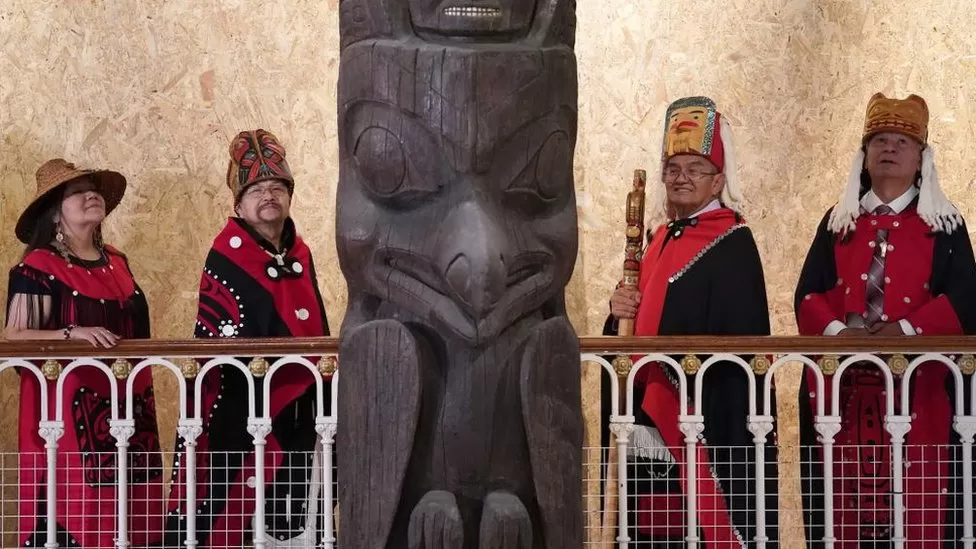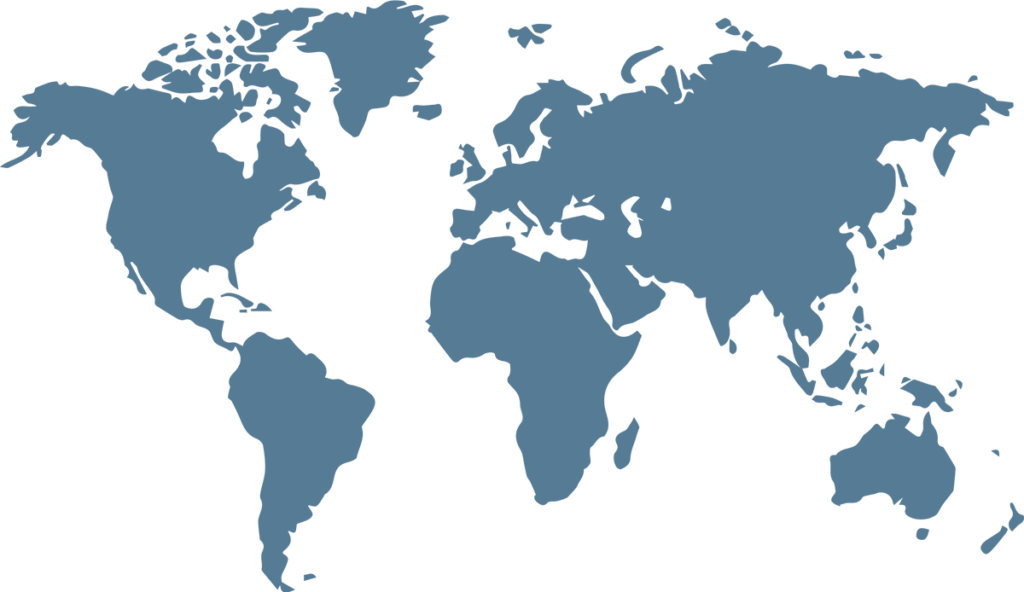After almost a century and a journey of thousands of miles, an artefact taken from Canada is now home. It is the first totem pole to be returned from a British museum to an indigenous community – a potentially precedent-setting moment in the broader move towards museum repatriation.
Museum curator Marius Barbeau had been eyeing the totem pole for some time.
It was the late 1920s, and the Canadian ethnographer had paid many visits to the Ank’idaa village in the Nass Valley, an indigenous community nestled between picturesque mountains, creeks and waterfalls in a remote part of British Columbia (BC).
There, he would photograph interesting items and send those pictures to museums around the world.
One item in particular, the Ni’isjoohl memorial pole, caught the attention of the Royal Scottish Museum – now known as the National Museum of Scotland.
They offered him between C$400 ($295; £240) and C$600 for the pole – estimated to be about C$7,000 and C$10,000 today – and Mr Barbeau obliged.
In the summer of 1929, when most Nisga’a people were away working, hunting, or fishing, he and his team simply took it.
The 11m (36ft) pole, carved mostly from a single piece of red cedar, had been commissioned to honour a warrior named Ts’wawit, who had died in battle.
After cutting the pole down, Mr Barbeau’s team bundled it onto a raft that floated down the river to Prince Rupert, on a journey that would eventually see it shipped more than 6,700km (4,200 miles) away to Edinburgh.
“We never gave him permission to steal our pole,” Amy Parent, whose great-great grandmother was the one to commission it in 1855 to honour her warrior son, told the BBC.
Now, nearly a century later, the Ni’isjoohl memorial pole is back in Nass Valley, welcomed by hundreds with an event marking its arrival on Friday.
The pole will be on display permanently at the Nisga’a Museum – a modern building with a stunning glass facade and surrounded by snow-capped mountains.
As it arrived, the morning’s misty weather shifted, leading to remarks on how the artefact was basking in its first sunshine in a long while.
Children placed cedar branches around the pole as it lay on its side in the light, and people queued to walk past and take pictures.
It was a historic “rematriation” not only for the family of Ms Parent, whose Nisga’a cultural name is Noxs Ts’aawit, but also for the indigenous nation of around 600 people.
“It sets out what we can do for our families who know about other artefacts that may have been taken from their possession,” said Eva Clayton, president of the Nisga’a Nation.
The return of the Ni’isjoohl pole could also set a precedent in a broader repatriation movement gaining steam around the world, as indigenous communities and nation states ask museums to return artefacts.
The journey home
The quest to get the pole back began last year, when a delegation, including Ms Parent, visited the National Museum of Scotland to formally ask for its return.
Ms Parent told the BBC that she felt emotional as soon as she entered the room where the pole was displayed.
“As we came up that escalator, we could feel the breath of our ancestors as we walked into the Living Lands exhibit where the pole was being housed,” she said.
The delegation explained to museum and government officials how the totem pole was taken and asked for its return without any conditions.
Within those conversations, Ms Parent said the delegation formed a deep connection with the Scottish representatives over a shared history of colonialism and its impact.
By December, the museum and the Scottish government knew what they would do. It was going home.
“This is the place where the spiritual and cultural significance for the pole is most keenly felt, and it makes absolute sense for it to be here with its people,” said Chanté St Clair Inglis, the head of collections services at the National Museum of Scotland, who attended the welcome ceremony in BC.
The pole began its month-long journey home this summer, starting with it being carefully manoeuvred out of a museum window and flown across the Atlantic to BC by the Royal Canadian Air Force.
It will be housed permanently in the Nisga’a Nation, where a place for it had been carved in the ground to symbolise a return to its roots.
Ms Parent said the community members will finally be able to learn the story of Ts’wawit and the significance of the artefact.
“We’ve always wanted our children to be able to not work so hard in order to understand the stories of who we are,” she said.
In Scotland, the national museum said it will use the totem pole’s now empty exhibit space to share the story of its return.
“This isn’t about us losing something,” Ms Inglis said. “This is about developing a relationship and telling [the pole’s] story in a much better way.”
Is this the first of many homecomings?
The return caught the attention of anthropologist and museum repatriation expert Chip Colwell.
Given how prominently displayed it was in Scotland and its significance to the Nisga’a Nation, it going home “is no small matter”, he said.
Mr Colwell, who is based in the US, said the tie forged between the Nisga’a Nation and the museum as part of this process “creates new possibilities for what museums themselves can do to repair the harms of colonialism”.
It is also part of a broader shift within the museum community in the last decades, as countries and museums grapple with how artefacts came into their possession.
Many European museums had been resistant to repatriation claims from indigenous peoples, he said. Now, the door is opening for the return of items of great ritual or religious significance.
“We’ve seen indigenous peoples becoming highly persuasive in convincing museums about how important these items are to them, and how often they were taken without consent,” Mr Colwell said.
Some countries – like France, for example – have also vowed to return looted treasures and artefacts, he added.
Mr Colwell is now watching to see whether other repatriation requests will be successful, such as Nigeria’s ask for the return of the Benin Bronzes, or Greece’s ask for the Elgin Marbles, both housed in the British Museum.
And he is optimistic about it.
“The museum world and most societies have recognised the need for repatriation as part of what it means to be a 21st-Century museum,” he said.
For indigenous communities in Canada, these repatriation requests carry extra significance given historical policies in the country meant to erase indigenous language and culture – policies since deemed a “cultural genocide”.
“The theft of their ritual items was part of that process,” Mr Colwell said.
Being able to get those items back, he added, “is fundamental to their survival as indigenous people”.
For the Nisga’a Nation president, the timing of the return of the Ni’isjoohl memorial pole makes it all that more significant as it took place on the weekend Canada marks the National Day for Truth and Reconciliation. It was created to recognise the harms of colonialism and the residential school system, where indigenous children were taken from their homes and enrolled in boarding schools in an effort to assimilate them.
Ms Clayton, a residential school survivor herself, said the return of the pole feels like its own form of reconciliation.
“What Scotland did was an incredible, kind gesture that will go a long way in helping to heal the hurts.”
Source : BBC


